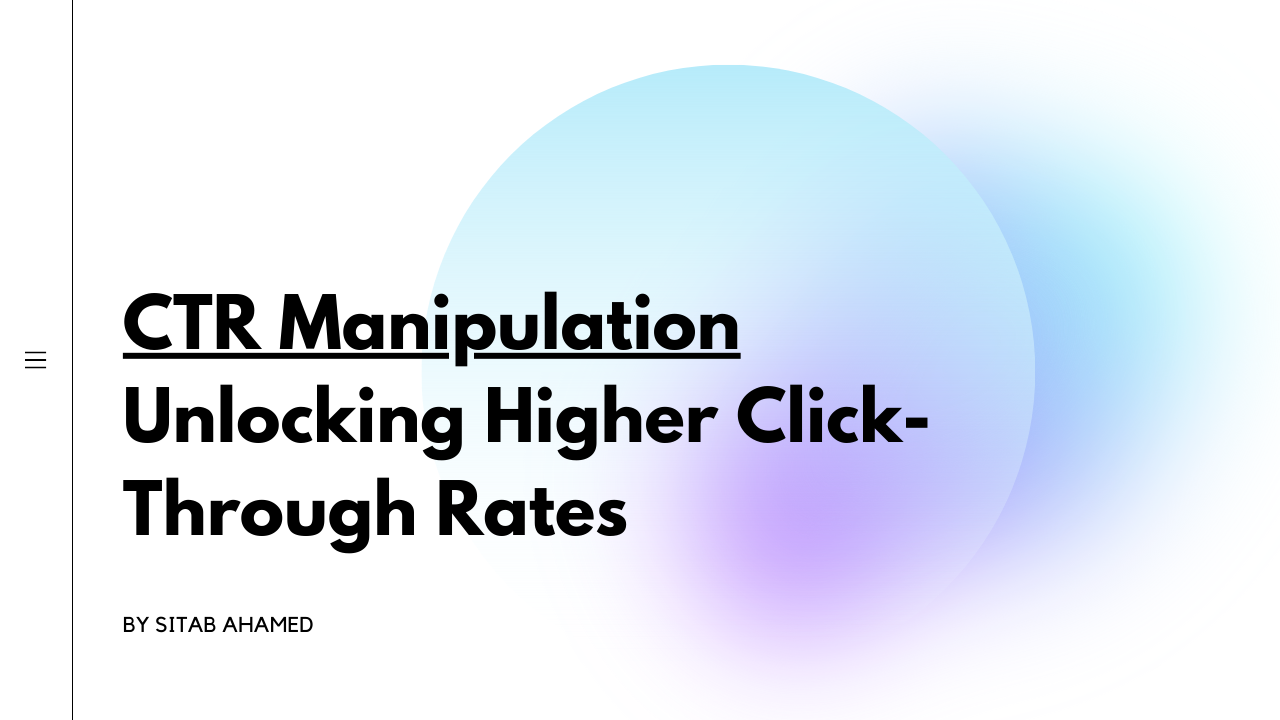CTR Manipulation: A Video Game Changer for Digital Projects
The increase of CTR control has undoubtedly changed digital advertising and marketing strategies, offering online marketers with tools to boost engagement and drive website traffic efficiently. What implications might this balancing act hold for the future of electronic campaigns?
Recognizing CTR Control
Although click-through rate (CTR) adjustment may feel like an uncomplicated tactic in electronic advertising, it incorporates a variety of methods intended at artificially pumping up engagement metrics. This control can take numerous forms, consisting of making use of click farms, robots, or deceitful advertisement placements that misdirect customers right into clicking. These approaches can jeopardize the stability of performance information, making it challenging for marketing professionals to evaluate the real efficiency of their projects.
Moreover, CTR control elevates honest concerns, as it threatens the transparency of electronic advertising and marketing. The dependence on filled with air metrics can lead to misguided advertising decisions, skewing source appropriation and project strategies. Consequently, companies may invest heavily in networks and techniques that show up effective however do not produce genuine interaction or conversions.

Benefits of Click-Through Price Optimization
Enhancing click-through rate (CTR) is crucial for improving the performance of electronic advertising campaigns. A higher CTR shows that a larger proportion of customers are involving with the material, which can result in increased internet site traffic and better conversion prices. By improving CTR, brand names can successfully assign their marketing sources to initiatives that produce the greatest returns.
Among the key benefits of CTR optimization is the possibility for enhanced advertisement positioning and lower prices - CTR Manipulation. Systems like Google Ads compensate higher CTRs with far better ad positioning and decreased cost-per-click (CPC), permitting marketing professionals to extend their budgets better. In addition, a well-optimized CTR can improve brand name visibility, as higher interaction rates often associate with raised natural reach

Techniques for Reliable CTR Manipulation
To successfully adjust click-through rates (CTR), marketers can utilize a selection of tactical methods that boost user interaction and drive web traffic. One essential strategy is optimizing ad copy to develop engaging and action-oriented language. CTR Manipulation. Utilizing strong call-to-action (CTA) expressions urges users to take immediate action, raising the likelihood of clicks
Another efficient method is A/B testing, which permits marketers to compare different ad variations. By systematically examining efficiency metrics, helpful site they can recognize which components resonate best with the target audience, consequently improving their approaches for optimal impact. Furthermore, leveraging aesthetically attractive graphics and concise messaging can catch interest swiftly, making it extra likely that users will engage.

Last but not least, maximizing touchdown web pages to ensure a smooth individual experience can minimize bounce rates and encourage further communication, inevitably promoting greater CTR. By integrating these techniques, online marketers can properly adjust CTR to achieve their project goals.
Measuring Success in Digital Projects
Determining success in digital campaigns calls for a clear understanding of crucial performance indications (KPIs) that align with project goals. KPIs function as measurable metrics that assist evaluate the effectiveness of numerous strategies used throughout the campaign. Common KPIs consist of click-through rates (CTR), conversion prices, expense per procurement (CPA), and return on investment (ROI)
To effectively gauge success, it is vital to establish details, measurable objectives initially of the campaign. If the main goal is to increase brand name awareness, metrics such as perceptions and interaction prices may be prioritized. In comparison, campaigns focused on straight sales would certainly gain from a more comprehensive evaluation of conversion rates and income created.
Regular evaluation of these KPIs enables marketing professionals to make data-driven choices, maximizing their methods in real-time. Using analytical devices can help in monitoring performance and determining fads, enabling speedy changes to improve project end results. Ultimately, an extensive technique to gauging success not just highlights areas for improvement yet also reinforces try this out the general performance of digital advertising and marketing initiatives, driving sustained development and engagement in the long term.
Future Patterns in Digital Advertising And Marketing
Preparing for the future of electronic marketing reveals a landscape formed by rapid technological advancements and altering consumer habits. As expert system and machine knowing continue to evolve, online marketers will increasingly leverage these modern technologies to individualize campaigns at an unprecedented range. Anticipating analytics will certainly make it possible for brands to prepare for consumer needs, enhancing ad placements and content distribution in actual time.
Moreover, the increase of voice search and wise devices is transforming exactly how consumers interact with electronic web content. Marketing experts will need to adjust their approaches to make certain presence across multiple platforms, consisting of voice-activated aides. This shift necessitates a concentrate on conversational marketing, stressing interaction with dialogue instead of typical marketing strategies.
In addition, privacy concerns are prompting changes in information collection techniques. Transparency and moral data use will come to be extremely important, driving brand names to promote trust and commitment among customers. The recurring evolution of social networks platforms will certainly likewise affect advertising strategies, with an increased focus on credibility and user-generated content.
Verdict
In summary, CTR manipulation represents a considerable improvement in digital marketing techniques, providing immediate benefits through enhanced engagement metrics. Nevertheless, the honest considerations surrounding such methods require a mindful strategy to make certain lasting brand name honesty and real target market connection. By striking an equilibrium in between optimization methods and authentic engagement, marketers can cultivate lasting relationships with consumers. The ongoing advancement of electronic advertising and my sources marketing will rely on this delicate interaction, shaping the future landscape of brand-consumer interactions.